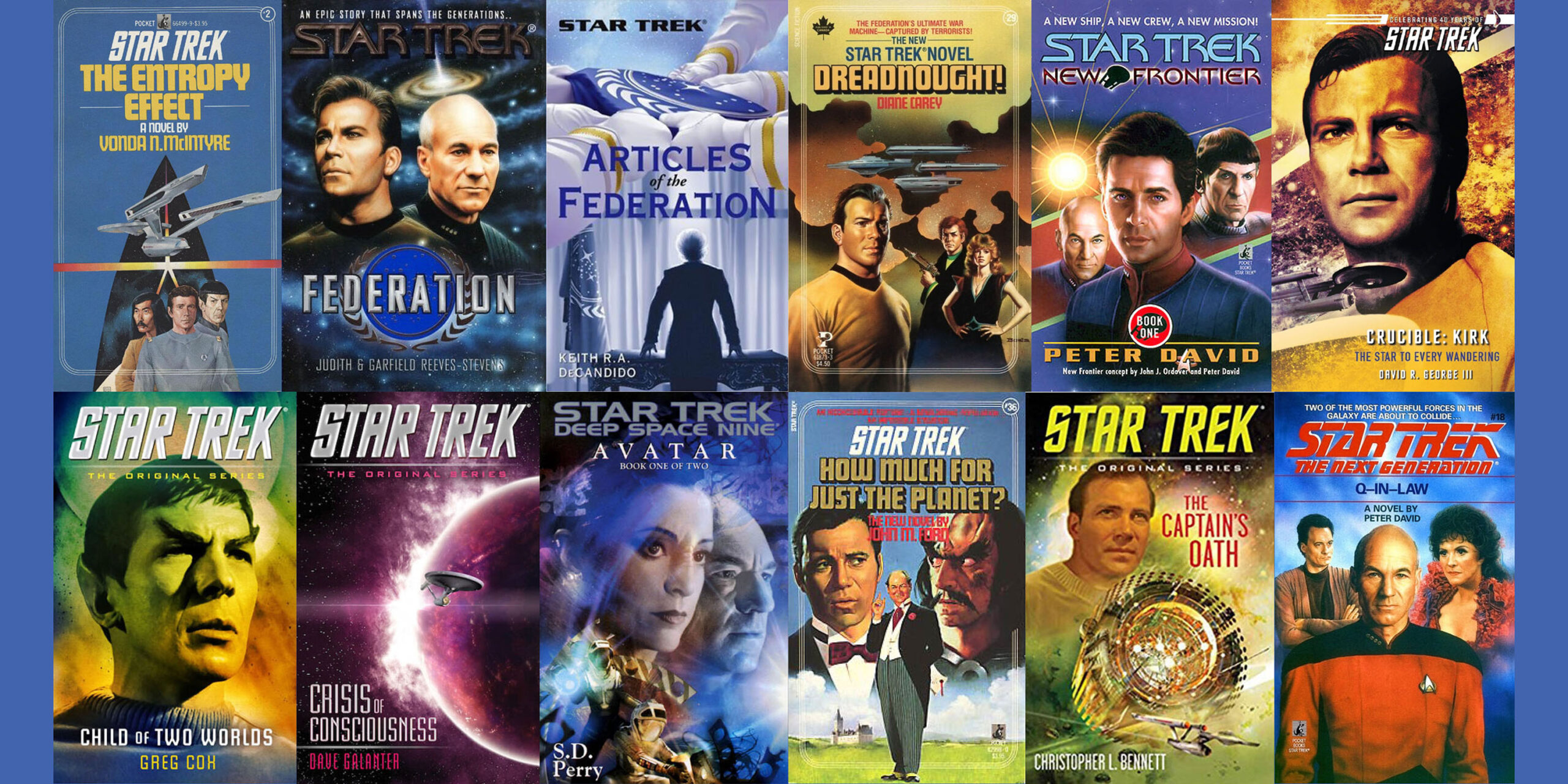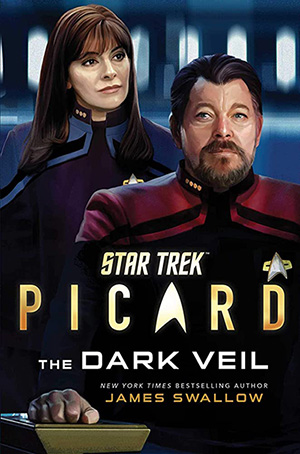
Star Trek: Picard: The Dark Veil

This story is set seven years after Nemesis and one year after the attack on Mars and Jean-Luc Picard’s resignation from Starfleet, as depicted in the first season of Picard. Tensions are high on the Federation-Romulan border, because the Picard-led efforts to help evacuate the Romulan worlds threatened by the destruction of the Romulan sun (as depicted in the 2009 J.J. Abrams Star Trek film) have been abandoned. When both Riker and the Titan, along with a Romulan ship, encounter a massive alien craft in distress, Riker and the Romulan captain must navigate those tensions while seeking to uncover the truth behind this alien species. Can they abandon their mutual mistrust in order to do so…?
I enjoyed this novel! I greatly admire Mr. Swallow’s spirited attempt, here, to merge the storylines and characters from the Titan novels with the new Picard continuity. I like seeing familiar characters from previous novels like Christine Vale and Ranul Keru and Karen McCreedy. I smiled at the reference to Riker’s first mission in command of the Titan involving Romulans, a nice nod to Taking Wing, the first Titan novel (and still one of the best.)
But for every similarity with the Titan novels, there are differences. Riker and Troi have a child, but it’s not Natasha, it’s Thaddeus (as per Picard). The depiction of the Romulans in the book incorporates the Picard season one version of Romulans as a culture focused on deception, obfuscation and puzzles. There’s also a major involvement of the Zhat Vash group, introduced in Picard — the Romulan cult who hate all artificial intelligence.
The shadow of all the things I disliked about Picard season one hangs over the story. I strongly disliked the dark timeline depicted in that first season of Picard, in which the Federation abandoned the Romulans to die, Picard gave up and left Starfleet, young Thaddeus Riker dies and Riker and Troi give up Starfleet too, etc. Knowing that this is the fate that awaits these characters makes much of the story in this book feel sort of hopeless to me. We know that Riker and the Romulan captain won’t be able to change things; we know that soon after these events Riker and Troi will quit Starfleet and retire, hiding away for much of the next decade and doing nothing to try to improve the situation across the galaxy.
But Mr. Swallow does what he can to redeem some of this story from Picard season one. I like learning, for example, that the Titan and the Enterprise, along with other starships, have been doing what they can to continue to aid the Romulans, despite the Federation’s public abandonment of all help. (We learn that these starships have been leaving unauthorized aid packages on planets near the Federation-Romulan border.)
Most interestingly, Mr. Swallow’s story gives us a hint of an explanation for Thaddeus Riker’s death, one that helps to fix one of the more nonsensical mistakes from Picard season one. On Picard, we learn that Thad died because the cure to his illness could only be found in a positronic net, which was forbidden because of Starfleet’s (idiotic) outlawing of all androids. This was one of the more egregiously frustrating moments in Picard, in which it was clear to me the show was being made by people who didn’t understand Star Trek or even basic storytelling. What connection does a positronic net (the basis for the brain of an android like Data) have to do with medicine for a human boy?? Absolutely none, of course. It makes no sense and shows the writers don’t understand what a positronic net is. (Also, they missed a much better option: Thad’s medicine should have been a cure that the Romulans had, but was now impossible to acquire because Starfleet had abandoned the Romulans. Wouldn’t that have made much more sense than trying to connect Thad’s death to the android storyline??) Anyways, Mr. Swallow rather ingeniously fixes this glaring mistake with his story. (I won’t spoil it!)
I was intrigued to again get a suggestion in this novel that the supernova that destroyed the Romulan Sun — and then Romulus itself — was not an accident. That was first hinted at in the first Picard novel, Una McCormack’s The Last Best Hope. This novel picks up that notion, seeming to suggest the supernova was caused by the actions of a secret group of Romulan scientists. I love this idea, because it helps fix a dumb plot point in J.J. Abrams’ 2009 Star Trek movie. It never made any sense to me that this supernova could just suddenly happen. How could an advanced interstellar civilization not know this was happening? So I like the idea that there’s more to this story, and that it wasn’t just a random accident that took the Romulans completely unaware (like Krypton). I wonder where/when we will get the rest of this story???
Other thoughts:
- I loved the suggestion that the Titan science officer Livnah might be from same species as Jaylah from Star Trek Beyond.
- It was nice to see Romulan warbird use their plasma weapon, something not seen since the very first TOS episode to introduce the Romulans, “Balance of Terror”.
- I smiled when the Romulan Helek shouts “fire everything!” in a moment of desperation, channeling Nero from 2009’s Star Trek.
- And, of course, I was even more happy when a Romulan says “It’s a fake!” — a reference to one of the best lines on Deep Space Nine.
- There was an interesting tidbit at the end of the book, with Spock. It was nice to see he’s still working with the Romulans, both continuing towards unification and also working on the supernova problem, along with the Vulcan science academy. It’s cool to connect what we saw in the 2009 Star Trek film and what we saw in Picard, and learn that Spock’s work within the Romulan empire continued, even after the Federation bailed. It was also interesting to see Spock looking to connect with Geordi on an engineering project. I assume this would be the red matter and Spock’s cool little ship from the 2009 movie. I’d love to see future books more squarely address these issues and tell this story, to better connect Picard and the 2009 Star Trek and fix the many discontinuities of those two installments, and even more importantly show us that many of our Starfleet heroes continued to be smart and heroic, working to try to help the Romulans and bridge the gap between these two enemies, the Romulans and the Federation, despite the grim, un-Trek picture that Picard season one painted.
I loved the book’s structure, in which we would shift perspective between chapters. It was fun that, as the story continued, we saw events from many different characters’ points of view, including the Romulans and the Jakari. I really enjoyed the development of the Jakari, a very interesting new alien race! I love it when Trek stories introduce us to cool, interesting new aliens.
Most importantly, I loved the book’s optimism and very Star Trek attitude of different cultures working together to solve a problem, even when they’re enemies. It’s a bummer that Picard season one told us that the next thirteen years of Trek history after the events of this book will be grim, with even Riker and Troi — seen here carrying on as noble, moral, heroic leaders in Starfleet even after Picard quit and ran away — soon also abandoning Starfleet and the troubles of the universe to live alone in the woods. Sigh. But that’s a problem with Picard and not this novel, which is a very enjoyable Star Trek story and one that admirably attempts to better mesh the continuity of the Picard show with the more familiar, upbeat depictions of these characters and the Star Trek universe.

Leave a Reply